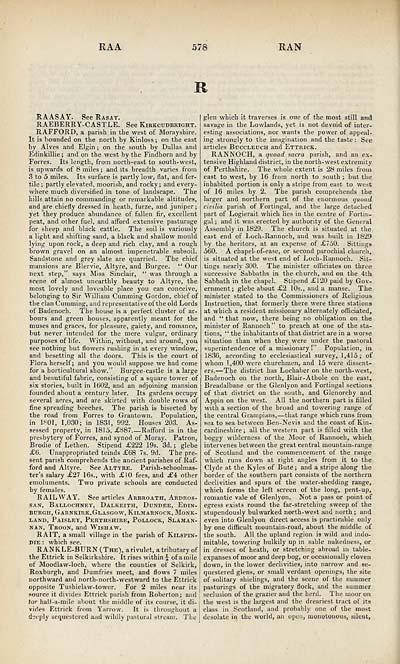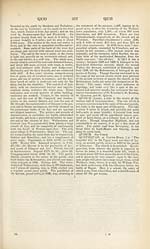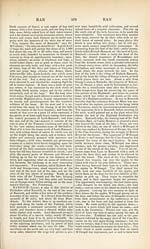Topographical, statistical, and historical gazetteer of Scotland > Volume 2
(596) Page 578
Download files
Complete book:
Individual page:
Thumbnail gallery: Grid view | List view

RAA
578
RAN
R
R A AS AY. See Rasay.
RAEBERRY-CASTLE. See Kirkcudbright.
RAFFORD, a parish in the west of Morayshire.
It is bounded on the north by Kinloss ; on the east
by Alves and Elgin ; on the south by Dallas and
Edinkillie ; and on the west by the Findhorn and by
Fon'es. Its length, from north-east to south-west,
is upwards of 8 miles ; and its breadth varies from
3 to 5 miles. Its surface is partly low, flat, and fer-
tile ; partly elevated, moorish, and rocky ; and every-
where much diversified in tone of landscape. The
hills attain no commanding or remarkable altitudes,
and are chiefly dressed in heath, furze, and juniper;
yet they produce abundance of fallen fir, excellent
peat, and other fuel, and afford extensive pasturage
for sheep and black cattle. The soil is variously
a light and shifting sand, a black and shallow mould
lying upon rock, a deep and rich clay, and a rough
brown gravel on an almost impenetrable subsoil.
Sandstone and grey slate are quarried. The chief
mansions are Blervie, Altyre, and Burgee. " Our
next step," says Miss Sinclair, " was through a
scene of almost unearthly beauty to Altyre, the
most lovely and loveable place you can conceive,
belonging to Sir William dimming Gordon, chief of
the clan (Summing, and representative of the old Lords
of Badenoch. The house is a perfect cluster of ar-
bours and green houses, apparently meant for the
muses and graces, for pleasure, gaiety, and romance,
but never intended for the mere vulgar, ordinary
purposes of life. Within, without, and around, you
see nothing but flowers rushing in at every window,
and besetting all the doors. This is the court of
Flora herself; and you would suppose we had come
for a horticultural show." Burgee-castle is a large
and beautiful fabric, consisting of a square tower of
six stories, built in 1602, and an adjoining mansion
founded about a century later. Its gardens occupy
several acres, and are skirted with double rows of
fine spreading beeches. The parish is bisected by
the road from Forres to Grantown. Population,
in 1P01, 1,030; in 1831, 992. Houses 203. As-
sessed property, in 1815, £887 Rafford is in the
presbytery of Forres, and synod of Moray. Patron,
Brodie of Lethen. Stipend £222 19s. 3d. ; glebe
£6. Unappropriated teinds £68 7s. 9d. The pre-
sent parish comprehends the ancient parishes of Raf-
ford and Altyre. See Altyre. Parish-schoolmas-
ter's salary £27 16s., with £10 fees, and £4 other
emoluments. Two private schools are conducted
by females.
RAILWAY. See articles Arbroath, Ardros-
san, Ballochney, Dalkeith, Dundee, Edin-
burgh, GAnNKiRK, Glasgow, Kilmarnock, Monk-
land, Paisley, Perthshire, Pollock, Slaman-
nan, Troon, and Wishaw.
RAIT, a small village in the parish of Kilspin-
dte : which see.
RANKLE-BURN (The), a rivulet, atributaryof
the Ettrick in Selkirkshire. It rises within £ of a mile
of Moodlaw-loch, where the counties of Selkirk,
Roxburgh, and Dumfries meet, and flows 7 miles
northward and north-north-westward to the Ettrick
opposite Tushielaw-tower. For 2 miles near its
source it divides Ettrick parish from Roberton; and
tor halt-a-mile about the middle of its course, it di-
vides Ettrick from Yarrow. It is throughout a
deeply sequestered and wildly pastoral stream. The
glen which it traverses is one of the most still and
savage in the Lowlands, yet is not devoid of inter-
esting associations, nor wants the power of appeal,
ing strongly to the imagination and the taste : See
articles Buccleuch and Ettrick.
RANNOCH, a quoad sacra parish, and an ex-
tensive Highland district, in the north-west extremity
of Perthshire. The whole extent is 28 miles from
east to west, by 16 from north to south ; but the
inhabited portion is only a stripe from east to west
of 16 miles by 2. The parish comprehends the
larger and northern part of the enormous quoad
civilia parish of Fortingal, and the large detached
part of Logierait which lies in the centre of Fortin-
gal ; and it was erected by authority of the General
Assembly in 1829. The church is situated at the
east end of Loch-Rannoch, and was built in 1829
by the heritors, at an expense of £750. Sittings
560. A chapel-of-ease, or second parochial church,
is situated at the west end of Loch-Rannoch. Sit-
tings nearly 300. The minister officiates on three
successive Sabbaths in the church, and on the 4th
Sabbath in the chapel. Stipend £120 paid by Gov-
ernment; glebe about £2 10s., and a manse. The
minister stated to the Commissioners of Religious
Instruction, that formerly there were three stations
at which a resident missionary alternately officiated,
and " that now, there being no obligation on the
minister of Rannoch " to preach at one of the sta-
tions, " the inhabitants of that district are in a worse
situation than when they were under the pastoral
superintendence of a missionary!" Population, in
1836, according to ecclesiastical survey, 1,415; of
whom 1,400 were churchmen, and 15 were dissent-
ers. — The district has Lochaber on the north-west,
Badenoch on the north, Blair-Athole on the east,
Breadalbane or the Glenlyon and Fortingal sections
of that district on the south, and Glenorchy and
Appin on the west. All the northern part is filled
with a section of the broad and towering range of
the central Grampians, — that range which runs from
sea to sea between Ben-Nevis and the coast of Kin-
cardineshire ; all the western part is filled with the
boggy wilderness of the Moor of Rannoch, which
intervenes between the great central mountain-range
of Scotland and the commencement of the range
which runs down at right angles from it to the
Clyde at the Kyles of Bute; and a stripe along the
border of the southern part consists of the northern
declivities and spurs of the water-shedding range,
which forms the left screen of the long, pent-up,
romantic vale of Glenlyon. Not a pass or point of
egress exists round the far-stretching sweep of the
stupendously bulwarked north-west and north ; and
even into Glenlyon direct access is practicable only
by one difficult mountain-road, about the middle of
the south. All the upland region is wild and indo-
mitable, towering bulkily up in sable nakedness, or
in dresses of heath, or stretching abroad in table-
expanses of moor and deep bog, or occasionally cloven
down, in the lower declivities, into narrow and se-
questered glens, or small verdant openings, the site
of solitary shielings, and the scene of the summer
pasturings of the migratory flock, and the summer
seclusion of the grazier and the herd. The moor on
the west is the largest and the dreariest tract of its
class in Scotland, and probably one of the most
desolate in the world, an open, monotonous, silent,
578
RAN
R
R A AS AY. See Rasay.
RAEBERRY-CASTLE. See Kirkcudbright.
RAFFORD, a parish in the west of Morayshire.
It is bounded on the north by Kinloss ; on the east
by Alves and Elgin ; on the south by Dallas and
Edinkillie ; and on the west by the Findhorn and by
Fon'es. Its length, from north-east to south-west,
is upwards of 8 miles ; and its breadth varies from
3 to 5 miles. Its surface is partly low, flat, and fer-
tile ; partly elevated, moorish, and rocky ; and every-
where much diversified in tone of landscape. The
hills attain no commanding or remarkable altitudes,
and are chiefly dressed in heath, furze, and juniper;
yet they produce abundance of fallen fir, excellent
peat, and other fuel, and afford extensive pasturage
for sheep and black cattle. The soil is variously
a light and shifting sand, a black and shallow mould
lying upon rock, a deep and rich clay, and a rough
brown gravel on an almost impenetrable subsoil.
Sandstone and grey slate are quarried. The chief
mansions are Blervie, Altyre, and Burgee. " Our
next step," says Miss Sinclair, " was through a
scene of almost unearthly beauty to Altyre, the
most lovely and loveable place you can conceive,
belonging to Sir William dimming Gordon, chief of
the clan (Summing, and representative of the old Lords
of Badenoch. The house is a perfect cluster of ar-
bours and green houses, apparently meant for the
muses and graces, for pleasure, gaiety, and romance,
but never intended for the mere vulgar, ordinary
purposes of life. Within, without, and around, you
see nothing but flowers rushing in at every window,
and besetting all the doors. This is the court of
Flora herself; and you would suppose we had come
for a horticultural show." Burgee-castle is a large
and beautiful fabric, consisting of a square tower of
six stories, built in 1602, and an adjoining mansion
founded about a century later. Its gardens occupy
several acres, and are skirted with double rows of
fine spreading beeches. The parish is bisected by
the road from Forres to Grantown. Population,
in 1P01, 1,030; in 1831, 992. Houses 203. As-
sessed property, in 1815, £887 Rafford is in the
presbytery of Forres, and synod of Moray. Patron,
Brodie of Lethen. Stipend £222 19s. 3d. ; glebe
£6. Unappropriated teinds £68 7s. 9d. The pre-
sent parish comprehends the ancient parishes of Raf-
ford and Altyre. See Altyre. Parish-schoolmas-
ter's salary £27 16s., with £10 fees, and £4 other
emoluments. Two private schools are conducted
by females.
RAILWAY. See articles Arbroath, Ardros-
san, Ballochney, Dalkeith, Dundee, Edin-
burgh, GAnNKiRK, Glasgow, Kilmarnock, Monk-
land, Paisley, Perthshire, Pollock, Slaman-
nan, Troon, and Wishaw.
RAIT, a small village in the parish of Kilspin-
dte : which see.
RANKLE-BURN (The), a rivulet, atributaryof
the Ettrick in Selkirkshire. It rises within £ of a mile
of Moodlaw-loch, where the counties of Selkirk,
Roxburgh, and Dumfries meet, and flows 7 miles
northward and north-north-westward to the Ettrick
opposite Tushielaw-tower. For 2 miles near its
source it divides Ettrick parish from Roberton; and
tor halt-a-mile about the middle of its course, it di-
vides Ettrick from Yarrow. It is throughout a
deeply sequestered and wildly pastoral stream. The
glen which it traverses is one of the most still and
savage in the Lowlands, yet is not devoid of inter-
esting associations, nor wants the power of appeal,
ing strongly to the imagination and the taste : See
articles Buccleuch and Ettrick.
RANNOCH, a quoad sacra parish, and an ex-
tensive Highland district, in the north-west extremity
of Perthshire. The whole extent is 28 miles from
east to west, by 16 from north to south ; but the
inhabited portion is only a stripe from east to west
of 16 miles by 2. The parish comprehends the
larger and northern part of the enormous quoad
civilia parish of Fortingal, and the large detached
part of Logierait which lies in the centre of Fortin-
gal ; and it was erected by authority of the General
Assembly in 1829. The church is situated at the
east end of Loch-Rannoch, and was built in 1829
by the heritors, at an expense of £750. Sittings
560. A chapel-of-ease, or second parochial church,
is situated at the west end of Loch-Rannoch. Sit-
tings nearly 300. The minister officiates on three
successive Sabbaths in the church, and on the 4th
Sabbath in the chapel. Stipend £120 paid by Gov-
ernment; glebe about £2 10s., and a manse. The
minister stated to the Commissioners of Religious
Instruction, that formerly there were three stations
at which a resident missionary alternately officiated,
and " that now, there being no obligation on the
minister of Rannoch " to preach at one of the sta-
tions, " the inhabitants of that district are in a worse
situation than when they were under the pastoral
superintendence of a missionary!" Population, in
1836, according to ecclesiastical survey, 1,415; of
whom 1,400 were churchmen, and 15 were dissent-
ers. — The district has Lochaber on the north-west,
Badenoch on the north, Blair-Athole on the east,
Breadalbane or the Glenlyon and Fortingal sections
of that district on the south, and Glenorchy and
Appin on the west. All the northern part is filled
with a section of the broad and towering range of
the central Grampians, — that range which runs from
sea to sea between Ben-Nevis and the coast of Kin-
cardineshire ; all the western part is filled with the
boggy wilderness of the Moor of Rannoch, which
intervenes between the great central mountain-range
of Scotland and the commencement of the range
which runs down at right angles from it to the
Clyde at the Kyles of Bute; and a stripe along the
border of the southern part consists of the northern
declivities and spurs of the water-shedding range,
which forms the left screen of the long, pent-up,
romantic vale of Glenlyon. Not a pass or point of
egress exists round the far-stretching sweep of the
stupendously bulwarked north-west and north ; and
even into Glenlyon direct access is practicable only
by one difficult mountain-road, about the middle of
the south. All the upland region is wild and indo-
mitable, towering bulkily up in sable nakedness, or
in dresses of heath, or stretching abroad in table-
expanses of moor and deep bog, or occasionally cloven
down, in the lower declivities, into narrow and se-
questered glens, or small verdant openings, the site
of solitary shielings, and the scene of the summer
pasturings of the migratory flock, and the summer
seclusion of the grazier and the herd. The moor on
the west is the largest and the dreariest tract of its
class in Scotland, and probably one of the most
desolate in the world, an open, monotonous, silent,
Set display mode to: Large image | Transcription
Images and transcriptions on this page, including medium image downloads, may be used under the Creative Commons Attribution 4.0 International Licence unless otherwise stated. ![]()
| Gazetteers of Scotland, 1803-1901 > Topographical, statistical, and historical gazetteer of Scotland > Volume 2 > (596) Page 578 |
|---|
| Permanent URL | https://digital.nls.uk/97501115 |
|---|
| Description | Volume second. I-Z. |
|---|---|
| Attribution and copyright: |
|

